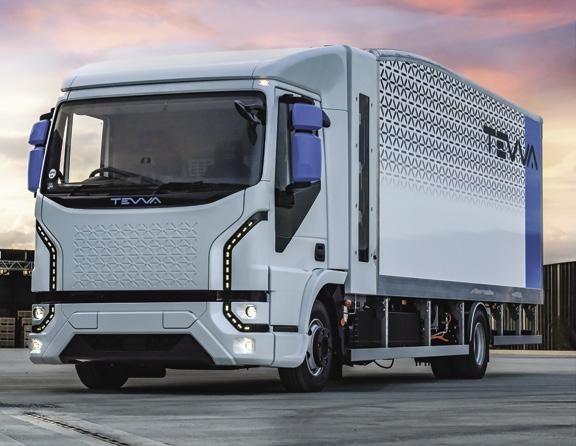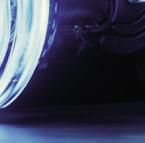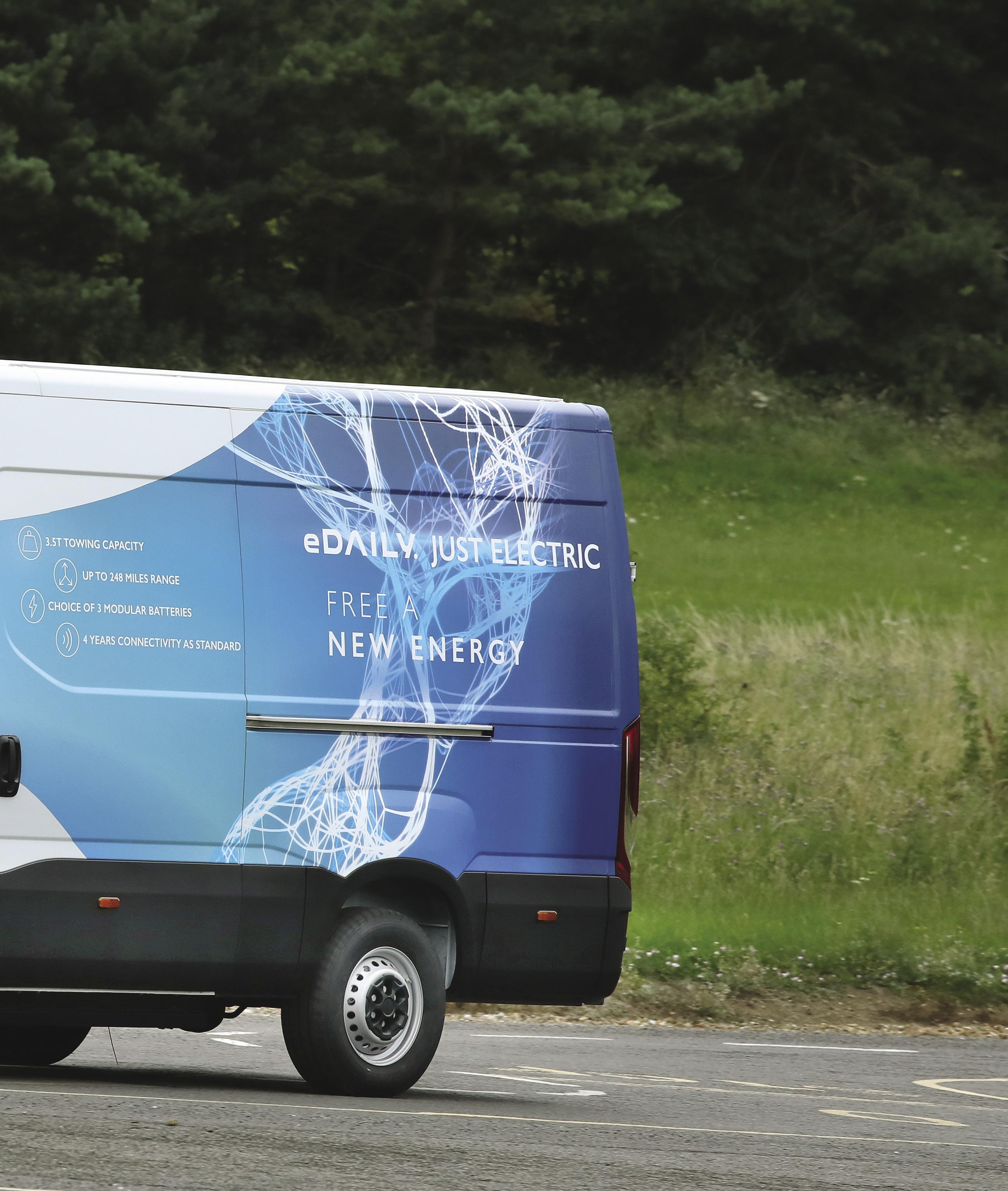
































Start your all-electric future now. We are ready to guide you through the transition to zero-emission transport. DAF can recommend and deliver the optimum truck configuration and charging strategy for your business. Plus, our trusted dealer network offers the facilities, expert advice and a dedicated driver training programme, ensuring you gain the maximum potential from your electric operation. DAF.COM/DAF-ELECTRIC









There are any number of reasons why the companies that run motorway service areas are unpopular with truck operators and drivers, including exorbitant pricing, poorquality parking, and shabby facilities, but it was a delight to hear Moto Hospitality boss Ken McMeikan explain the harsh reality of the Government’s decarbonisation ambitions on BBC Radio 4’s Today programme.
Moto’s man explained that while he had installed car chargers in his network, on four service areas the chargers were doing nothing because there was insufficient capacity on the local electricity grid to power them.
He said that unless targets are set for power companies to provide enough power for charging points across the country, it will simply not be possible.
“Getting the right number of chargers is not a challenge,” he said. “Getting enough power for those chargers to actually operate well enough for EV drivers is a major, major problem.”
He explained: “There was a target set for the number of chargers by the end of 2023 that there would be at each motorway service area and that was a minimum of six.
“Sadly what there hasn’t been is a target set for the power companies of the amount of









power that’s going to be required to operate those chargers and also a time commitment for the power companies of when that power would be made available ready for those chargers to start to operate.
“We have got a situation... where we’ve put sufficient chargers on four of our motorway service areas and the power required once the chargers were put in place is not available. So EV drivers are turning up to motorway services at four of our locations and there are chargers sitting there but no power.”
The situation would only get worse, he warned. By 2030 the “scale of power” required to meet demand for charging at motorway services would be 12 times what it is today.
“I don’t believe the grid at the moment has the infrastructure and the power available at the time that it’s going to be needed,” McMeikan said.
“What the government needs to do is they need to set targets on a year by year basis, side by side, region by region, to ensure that there is sufficient power to be able to operate the chargers.”
Indeed.
And what’s really worrying is that Mr McMeikan’s calculations appear not to include
the specific charging needs of commercial vehicles.






It’s now apparent that the Government’s targets for ‘decarbonising’ transport by banning internal combustion engines have not been thought through, and are probably unattainable. After all, they were scribbled down in the last days of Theresa May’s premiership.
What would be more realistic would be to scrap the ban on internal combustion altogether, and instead set targets for a viable grid of vehicle recharging points. Electric vehicles could then compete, on their own merits, against other current and emergent technologies including efuels, hydrogen fuel cells and biomethane, with individual vehicle buyers choosing what works best for them.
This issue contains road-tests of two battery-electric vans: both of which have their merits, and also constraints that are unique to BEVs, including the inevitable range/payload compromises. We’ve also got news of a spectrum of workable alternatives to BEV, many of which are more suitable to the commercial environment and will work on existing vehicles, now. In the absence of a working national public charging grid, shouldn’t the Government at least create legislative space for them all in the UK?
Matthew Eisenegger, Publisher
INFORMATION
EDITORIAL
Publisher: Matthew Eisenegger
Managing Editor: Richard Simpson
Designer: Harold Francis Callahan
Editorial Address: Commercial Vehicle Media & Publishing Ltd, 4th Floor 19 Capesthorne Drive, Eaves Green, Chorley, Lancashire. PR7 3QQ

Telephone: 01257 231521
Email: matthew@cvdriver.com
ADVERTISING

Advertising Sales: David Johns
Telephone: 01388 517906 Mobile: 07590 547343
Email: sales@cvdriver.com

DESIGN
Art Editor: Harold Francis Callahan
Telephone: 01257 231521
Email: design@cvdriver.com
CONTRIBUTORS
Steve Banner





































Grahame Neagus
PUBLISHED BY Commercial Vehicle Media & Publishing Ltd, 4th Floor, 19 Capesthorne Drive, Eaves Green, Chorley, Lancashire. PR7 3QQ
Telephone: 01257 231521

NOTE
The publisher makes every effort to ensure the magazine’s contents are correct. All material published in Destination Net Zero magazine is copyright and unauthorised reproduction is forbidden. The Editors and Publisher of this magazine give no warranties, guarantees or assurances and make no representations regarding any goods or services advertised in this edition.
Destination Net Zero magazine is published under a licence from Commercial Vehicle Media & Publishing Ltd. All rights in the licensed material belong to Matthew Eisenegger or Commercial Vehicle Media and Publishing Ltd and may not be reproduced whether in whole or in part, without their prior written consent.
If you are not going to keep this magazine for future reference please pass it on or recycle it.
Peugeot ePartner Road test:











Electric
14 E
12 6, 8, 10 & 11 News Hydrogen strategy, Iveco takes Nikola’s Euro operation, Alternative fuels demand rises 4 destination net zero | issue 8

















–“The journey towards a cleaner transport world has started. Join us for Destination Net Zero.” VISIT: www.destinationnetzeromagazine.co.uk








Will SCAN ME
17 Logo needs to be 240mm wide Logo should start 140mm below the bottom of the collar DESTINATION needs to be in white







































At Renault Trucks we are pioneers in electric vehicles. Our experience, and that of our expert partners, can help you introduce electric vehicles to your fleet, and reduce CO2 emissions to the benefit of us all.




















renault-trucks.co.uk














UK hydrogen truck pioneer HVS has launched a five-point plan to encourage the adoption of hydrogen-powered HGVs and a wider hydrogen strategy in this country.
CEO Jawad Khursheed said: “This industry desperately needs clarity from the UK government on incentives to encourage the early adoption of hydrogen HGVs, alongside commitments to support the development of new H2 technology, green hydrogen infrastructure and revisions to regulations.
The five-point plan covers incentives, legislative and regulatory changes, green hydrogen production, infrastructure, and an upskilled workforce.

It calls for financial support for operators, with cost clarity to encourage investment in new fleet technologies. It wants a definite cut-off date for the use of diesel trucks, and reform of transport legislation to enable the transportation of large quantities of hydrogen for long distances. Production of green hydrogen must be increased, and better infrastructure provided for electric and
hydrogen-powered vehicles. More investment in science, technology, engineering and mathematics (STEM) education is needed to supply a competent workforce for vehicle manufacturers and tier one suppliers in the hydrogen industry.
“Our roadmap shows how the haulage industry can seamlessly move from fossil-fuelled fleets to green hydrogen HGVs, enabling the UK to remain competitive globally and ensuring climate change goals are met,” Mr Khursheed concluded.
• The Disruptors: Page 32
The number of businesses offering on-site electric vehicle charging is set to double in the next year, according to research from Arval Mobility Observatory.
Currently, 20% of businesses have charging available at their premises, but the report reveals that this is set to increase to 40% within 12 months.

Shaun Sadlier, Head of Arval Mobility Observatory in the UK, said:
“This represents a relatively important shift in supporting drivers who choose or are provided with an electric car or van through their employer. It means EV drivers visiting other companies should be able to increasingly access charging for their return or subsequent journey, saving time and presumably also accessing cheaper power than if they had to pay for public charging.

“One of the considerations that businesses need to think through is the mix of charging points which they install. One set of drivers may need access to a rapid charger to get sufficient additional miles, while
for another group of drivers a slower charger will be adequate.
“Whether this all materialises in exactly the manner we’d hope is difficult to say – employees could ‘hog’ the chargers on their own company car park, but it does hopefully mark the beginning of a crucial infrastructure shift towards noticeably wider charger availability.”
However, Arval Mobility Observatory Barometer also shows a decrease in the percentage of companies offering free charging, probably as a result of recent increases in the cost of electricity.
“Since this question was asked in last year’s research, the number of fleets offering free power at their premises has fallen from 29% to 17%. As an effect of soaring prices, it has simply become too expensive for many to continue to give electricity away,” Shaun Sadlier reported.
To discover more about the Arval Mobility Observatory and the 2023 Barometer findings, visit: bnpp.lk/ev-charger-insight.



• Unlock the value of your existing assets
• Invest in new vehicles
• Create positive cash flow for your business
closeasset.co.uk/dnz

Products and services are subject to eligibility, status, terms and conditions and availability.
All lending is subject to status and our lending criteria. The right to decline any application is reserved.
Close Brothers Asset Finance has a strong history of helping businesses meet their emission targets by either upgrading or converting their vehicles. The people responsible for this is the National Accounts & ESG team, who are a team of asset finance experts who work with businesses across the UK, specialising in dealer and manufacturer relationships with a focus on new and emerging technology in the Transport sector.
They look at Alternative Fuel Vehicles (AFV), including EV and Hydrogen, Last Mile Delivery Solutions, Charging and refuelling infrastructure and other low emission alternatives to the traditional ICE markets.
According to Andrew New, Head of National Accounts & ESG, early engagement with new and developing technology is key, as they strive to understand the challenges the sector is facing.
“We work closely with manufacturer and vendor partners to create bespoke funding solutions and increase sales to the end user markets with Hire Purchase, Finance Lease and Operating Lease structures.
“We assist in the purchase cycle by dealing directly with the end user customers to create a bespoke solution that matches their requirements.
“We focus on the traditional ‘heritage’ markets, as well as the new and emerging technologies in both established vehicle classes, along with the new to market products that are being produced to be compatible with the net zero targets for the UK and Europe.”
How can Close Brothers Asset Finance help?
The team offers flexible finance solutions to help businesses convert or
upgrade their fleet of vehicles to meet emission requirements.
Vehicle conversions – the team can help businesses who are looking to convert their current vehicles to meet the requirements. They can make this possible with tailor-made, practical refinance options.

“Refinancing allows you to quickly release funds from your existing vehicles and re-invest this into the conversion,” explained Andrew. “We also provide flexible finance solutions to help businesses purchase new, compliant vehicles.
“Our people are experts in asset finance and consider all relevant aspects of a business to create tailor-made, flexible repayment schedules to suit most situations.”
For more information, please visit closeasset.co.uk/ESG
Close Brothers Asset Finance is a trading style of Close Brothers Limited. Close Brothers Limited is registered in England and Wales (Company Number 00195626) and its registered office is 10 Crown Place, London, EC2A 4FT.


Iveco has taken over the production and marketing of the battery and fuel cell heavy-duty trucks it previously produced for the Nikola Iveco Europe joint venture. After displaying a Nikola-badged vehicle at the Commercial Vehicle Show in April, Iveco took full control of the jV in June, and will now market the battery-electric and fuel-cell trucks under its own name. The Iveco HD BEV and FCEV feature an electric axle produced by FPT Industrial, Iveco’s powertrain specialist sister brand. Batteries are supplied by Proterra, and fuelcell technology and key components by Bosch. The vehicles are based on the Iveco S-Way truck platform, which has been redesigned to support fuel-cell and battery technology.
The Iveco HD BEV has a range of up to 500 km. It features a total battery capacity of 738 kWh, with charging power up to 350 kW, which enables hub-to-hub delivery missions, a wide range of regional applications, and even extended mileage journeys if charging can be accessed during mandated driver stops. It will enter the European market in 4x2
Clothing specialist Trotters Childrenswear’s has replaced two older diesel vans with an all-electric E-Tech Master from Renault Trucks. Supplied by Renault Truck Commercials, Chiltern, the new E-Tech Master will average 20-30 miles per day and work in close proximity to Trotters Childrenswear’s fulfilment centre where the vehicle will also be charged.
Natasha Lunney, Chief Operating Officer at Trotters (Childrenswear & Accessories) Limited, said: “We selected Renault Trucks because it’s a well-trusted brand and has a reputation for reliability, and because they had the size and style of van we were looking for to deliver our stock.”

Providing a payload of up to 1.2 tonnes, the new van’s Truckcraft low-loader box body offers a floor-height of just 500mm which allows for a greater load volume of 19 cu m, enabling the delivery fleet to be reduced from two vans to one.
tractor configuration in the last quarter of 2023.
The Iveco HD FCEV’s range is up to 800 km. With a fast refuelling-time of under 20 minutes, it is better suited for long-haul heavy transport. It can accommodate 70 kg of usable H2 at 700-bar pressure. The first Iveco HD FCEVs will be delivered in France, Switzerland and Germany at the year-end, as planned in the H2Haul European project.
Both vehicles are produced at Iveco Group’s Ulm site in Germany. Vehicles will be marketed and supported by the extensive Iveco dealer network of 254 dealers around Europe.

• Iveco’s former JV partner, Nikola Motor, has received a new order from USA freight forwarder JB Hunt for ten battery-electric and three fuel cell-powered vehicles.


Nikola now claims to have orders for over 200 fuel-cell trucks. The first JB Hunt truck delivery is scheduled for August, and Nikola has won Government funding worth $15.3 million to build seven open-access hydrogen filling stations in California.

Fleet operators who don’t start moving towards electrification today risk being caught in a supply chain crunch later in the decade, warns independent maintenance provider Sapphire Vehicle Services.


As the end of combustion engine production looms, any businesses not already preparing to make the switch could find themselves caught in a race against time to acquire vehicles, set up charging infrastructure and ensure they have the right specialised workshop support – that’s the view of Sapphire Managing Director Perry Reeves.
“Fleets are at the heart of the UK economy and are the among the biggest influences on energy transition, contributing an estimated 10% of the UK’s total carbon emissions,” he said. “Along with the forthcoming legislative changes, that means there is increasing pressure on transport operators to electrify, as well as significant business and reputational benefits to be unlocked through electrification.
“Managing the transition will require significant preparation, investment and support from the right partners. At Sapphire Vehicle Services we’re ideally positioned to help busy operators plan, design and deliver scaled enterprise fleet solutions. We’ll help you optimise your fleet, charging and operations to make electrification an opportunity, not just an obligation.”

Reeves and his leadership team recognised the need to play their part in the journey towards electrification several years ago: as a result, Sapphire is already well down the road, having invested in its people and facilities.
“We designed bespoke training platforms to deliver more IMI accredited EV level 3 and 4 technicians than any other national fleet repairer,” Reeves asserted. “Our vision was to provide a safety net for the operators transitioning to electric. We’re also delivering on-site charging at all of our IRTE accredited workshops, and offering support from our mobile service vans which are fitted with 125KVA super chargers –

with the aim of helping our customers deal with any hurdles as they learn to adapt to range and usage changes.
“We’re working with key partners to build a robust and extensive network from supply of vehicles to charging and aftersales support, while every one of our 350+ employees will be equipped with the tools to safely advise operators and service fleets while they move from fossil fuel to fully electrified.
“Existing Sapphire customers can take confidence from the fact that the same familiar faces who have supported their conventional diesel-powered fleets will have the expertise to handle their new battery-electric vehicles, ensuring business as usual. Meanwhile newcomers to Sapphire Vehicle Services can be assured we have many years of experience delivering industry-leading standards of vehicle up-time, MOT pass-rates and support to the most important areas of road transport.
“We are ready! Are you?”

Low-carbon fuel supplier Gasrec is reporting the highest demand for biomethane in the company’s history, with volumes reaching an all-time high in June 2023 – and set to continue rising thanks to pending orders from fleets for new gas-powered trucks.

June’s gas sales represented a 250 per cent increase from March 2020’s figure, when demand had been soaring prior to the pandemic.
James Westcott, Chief Operating Officer at Gasrec, said: “Fleets are under pressure from customers to decarbonise, and Bio-LNG (liquified natural gas) is the most viable, readily-
available solution – plus it’s suitable for longerhaul missions, with quick refuelling times.
“This year we’ve already opened three new refuelling facilities in Lutterworth, Fradley Park and South Elmsall, increasing our network to 16 sites, and with three more due to be installed before the end of the year.”
Commenting on the road transport industry’s appetite for biomethane, he added: “Our fuels are once again significantly cheaper than diesel, meaning customers can save money whilst improving sustainability. For fleets looking at gas trucks today, our number one message is to talk to your fuel provider as
soon as possible, to ensure they can have the refuelling infrastructure in place where needed and understand gas pricing. The demand right now is exceptional.”
Gasrec reports that operators of all sizes are turning to biomethane, from some of the country’s largest logistics and own-account operators, to family-owned haulage businesses and SMEs.
The supply of biomethane is an important part of the energy transition for the HGV sector, providing a commercially viable option for fleets to reduce their carbon footprint by up to 85 per cent in comparison to diesel.

TIP Group has supplied Vantec with seven new DAF XF tractor units powered by Hydrotreated Vegetable Oil (HVO), helping the Sunderland headquartered third-party logistics provider boost its sustainability goals as part of its UK expansion.
Vantec, one of the UK’s top logistics solutions and final mile delivery providers for the automotive and premium automotive parts industry, will see its fleet benefit from a 90 per cent reduction in CO2 emissions when running HVO fuelled trucks. The DAF XF trucks also benefit from the manufacturer’s latest generation of aerodynamic advances, which reduce drag and lower fuel consumption ever further.
Alongside the seven DAF XF trucks, TIP has supplied Vantec with 16 new SDC Freespan ENXL curtainsided trailers.
In the coming months, two 18-tonne DAF rigids will be added to complete the fleet update.

Chris Bain, general manager (Transport, Facilities & Operations) at Vantec, commented: “We are delighted with these latest additions to our fleet, which have come as part of our expansion into the north-west of the UK. This is the first time we have used HVO trucks in our fleet and we look forward to enjoying the low emissions advantage which they will bring. These new trucks, supplied through our partnership with TIP, have made it possible for us to make strides towards our goal of being a zero-emissions logistics provider by 2050.”
Mike Furnival, managing director of TIP said, “We are always looking to support our
customers with their journey towards zeroemissions and through the provision of these latest generation HVO powered DAF XF trucks we are doing just that. These advanced units provide the versatility of a traditional diesel truck, but with up to 90% less emissions, which helps our customers achieve their sustainability goals, while retaining operational efficiencies.
Introducing HVO fuel to its fleet has helped a leading heating, plumbing and air-movement materials supplier significantly reduce its carbon footprint.
TG Lynes started using HVO in two of its 18-tonne Euro VI trucks late last year. They are refuelled from a 10,000 litre HVO tank installed at its Enfield base, producing additional benefits including significant time efficiencies and cost savings.

The switch has proved so successful both environmentally and economically that TG Lynes is now considering rolling out HVO across all of its trucks.

Transport supervisor John O’Connell said: “We made the decision to try HVO in two vehicles to see how it worked.
“We knew that our carbon emissions from these two vehicles would reduce by around 90 per cent, but we hadn’t fully appreciated the additional benefits the move would bring.
“The MPG of each vehicle has improved. These vehicles tend to do quite short journeys within the M25 with plenty of stopping and starting.
“When we were using regular diesel the MPG averaged 11.5. During a similar month this year, with comparable journeys completed, it was 13 MPG.
“With our HVO tank on site, there is no queuing or forethought required – the fuel is waiting each morning, allowing us to get on with our deliveries.”
“It’s been a really positive test and we are considering rolling out HVO across other vehicles in the fleet – and perhaps, in time, across all of them.”
The projected carbon saving through the course of 2023 from the two HVO trucks is 15 tonnes – the approximate amount an average car would emit were it to drive once around the world.


Compliance. Done digitally
Driver Check, Fleet & Workshop Management
www.truckfile.co.uk
“Addressing these potential problems sooner translates into a noticeable reduction in downtime.”
Lee Thompson-Halls National Fleet Manager at Wren KitchensSapphire Vehicle Services is here to support forward-looking operators on their journey towards electrified transport.

Our 16 IRTE-accredited, 24/7/365 workshops feature charging points, trained EV technicians and tooling – we’re perfectly positioned to help you switch.

Sapphire is proud to be appointed as the first UK Certified Service Partner for electric vehicle manufacturer and Truck as a Service provider, Volta Trucks.
Your Fleet. Our Passion.


As 2023 is set to be the hottest year in history, heralded by record temperatures and wildfires across Southern Europe and the Americas, the news has been awash with commentators and businesses calling for urgent action by a variety of means, not least the transition to zero-emissions vehicles.
Here in the UK the Government is set to implement the new ZEV Mandate from 1st January 2024 for all OEMs. Assuming this stays in its current guise, the mandate will require all car and van OEMs a minimum percentage target of zero emission vehicles to be registered each year. For LCVs, this starts at 10 percent for 2024, rising every year until we hit 70% by 2030 and 100 percent by 2035.
For many outside our industry looking in, this is a welcome set of targets that will contribute to overall CO2 reduction, and which, on the face of it, sound reasonably easy to achieve and must surely accelerate production – and uptake - of ZEVs.
For those of us inside the industry however, there are some challenges, with 2024’s target swiftly followed by the huge jump in 2025 to 19% of LCV registrations. The reality is, if the buying public do not get on board and purchase zero emission vehicles, opting either to keep their existing diesels or indeed buying what could be their last or second to last ICE models, then trying to balance the overall production volumes of global OEMs and the percentage of EVs within that will be no mean feat – or pay the fine for non-compliance.
On a recent journey to East Anglia, I passed a large field, filled with a sea of
brand new, pre-registered electric cars and vans from another OEM. By the looks of the registration plates, these vehicles were probably pre-registered to hit the 2022 target, but I do wonder if this might be a sign of the future as manufacturers take extreme measures to avoid ZEV mandate fines, only to be left with huge volumes of pre-registered stock that is in excess of the market demand.
As an industry, we support the Government’s 2050 Net Zero target, and we are playing our part. Yet we still need more from the Government in terms of incentivising operators to make the switch to zero emission vehicles, as well as how
it intends to plug the gap that will inevitably be left once the tax revenue from diesel sales finally dries up.
As part of our approach here at Renault Trucks, our strategic philosophy is to deliver the best, most efficient vehicle for our customer’s application. And whilst we believe that, with a routeplanning approach, 90% of urban operations should be within the scope of a battery electric vehicle by the end of 2023, the latest, ultra-clean Euro VI Step E diesel engines may still best suit an operator’s specific needs and application complexity, especially if they choose to run it on HVO as a stepping stone towards net zero. In a time when diesel engines are at their cleanest and most efficient, the route to net zero must be about taking a blended approach, starting with those
applications such as last mile logistics where an EV variant is well suited to the operator’s needs, today and in the future.
It’s already happening. In the heart of our cities, across the UK and mainland Europe, you will see the huge explosion of last mile and last metre logistics solutions like the eCargo Bike. Recently celebrated in the 4th annual Cargo Bike Cruise, over 200 businesses around the London Bridge area alone have made the switch since 2019. Taking to cycle paths and city roads, many are abandoning the conventional van, regardless of fuel type, for the versatility and speed of an eCargo Bike. And whilst this is great news, for many van OEMs that’s another potential EV van sale gone in their quest for hitting the mandate’s minimum figure.

We will make it work because we have to make it work. OEMs are investing billions in bringing innovations and new technologies to market. But we can’t do this alone. We need government support to assist in the transition, from EV infrastructure to incentivising near zero fuels as a stepping stone, or helping operators transition with more fiscal incentives to purchase the right asset today rather than leaving it to later on in the decade.
In an economy where we are all looking to reuse, recycle and be sustainable, the thought of seeing more fields of new vehicles, built and registered many months ago, parked up rather than fulfilling their green potential, just to enable OEMs to hit their ZEV mandate targets feels very wrong.



“90% of urban operations should be within the scope of a battery electric vehicle by the end of 2023”
• Grahame Neagus














Scania UK has completed a deal with Consortium Purchasing group to deliver 100 battery-electric trucks over the next 12 months.
for the industry, those BEV 4x2 tractor units will be split across Consortium’s members: Culina Group, WS Group, A.W. Jenkinson Group and its subsidiaries, becoming among the first Scania EV tractors to enter service in the UK.
In what has been coined as a one of Scania’s largest BEV orders to be fulfilled in one calendar year, Christian Levin, Chief Executive Officer for Scania AB, said this deal is a significant milestone in the two organisations’ history, and shows the intent to move towards more sustainable transport solutions, adding: “Scania has had a close and successful relationship with Culina Group, WS Group and A.W. Jenkinson Group for many years.”
In a pivotal moment
These 100 battery electric trucks are Scania’s regional-haul 4x2 tractor units, officially launched in June 2022, with customers originally expected to start taking first deliveries in Q1 2024. They are powered by a triple electric machine powertrain, producing approximately 560hp, and are equipped with an electric power take-off system to support temperature controlled or bulk transportation.




They are also the first Scanias to come fitted with the Northvolt battery cells giving 468 kWh of usable capacity, which yields a range of up to 350km.


“These trucks are powered by a triple electric machine powertrain, producing approximately 560hp”






Christian says: “This vehicle represents a major milestone for us and for our partners. “We’ve increased our range and are offering new opportunities to cater for a wider selection of customers and the whole transport ecosystem. These trucks are part of the solution that the transport industry is asking for.”

Alongside these trucks, Consortium Purchasing is purchasing another 2,400 vehicles, including 2,250 diesel trucks powered by Scania’s latest generation and efficient 13-litre SUPER powertrain. The other 150 are earmarked to support the Consortium’s German and Dutch operations.
William Stobart, Deputy CEO of Culina Group, was delighted by the deal, stating the group of companies were pleased to renew their agreement and relationship with Scania.
“It’s been a difficult time for all the OEMs with global supply issues,” he adds. “But Scania has worked closely with us over the past two years to minimise the impact for both parties. This is testament to the true partnership between the businesses.”
Chris Newitt, Managing Director for Scania UK, concurred adding this was the perfect opportunity to cement the ongoing relationship between the two companies during a period of such transition.
“It’s testament to the strength between the two organisations that we can make this announcement,” Chris adds. “But also, to those involved in making it possible over the many years that this deal is built upon.”

This has been confirmed as one of Scanias largest European and battery-electric vehicle orders to be completed over one calendar year by Scania.

The vehicles will be delivered to the group in batches of at least 500 per quarter.


“It’s testament to the strength between the two organisations that we can make this announcement”
Thermo King EMEA enhances its “digital chassis” to bring digitally enhanced capabilities to upcoming cooling units
By Wouter Roels, Business Development Leader, Thermo KingDigital transformation is on a scale like we’ve never seen before, and real-time connectivity is one of the key ingredients fueling it. No industry will be left untouched, including the temperature-controlled transport industry.
Thermo King is leading the way in a transformation that is changing the industry and the way its customers conduct business. Here are some insights on how Thermo King is working together to make it happen.
• Digitalization is a key strategic initiative for Thermo King.
• The digital chassis is a key accelerator for the transition to full electric, emission-free cooling units.

• Customers will be able to show lower emissions and contribute to a reduction in food loss.
It is clear that digital solutions are becoming table-stakes in global cold chain logistics as customers demand greater visibility. As one of the three critical strategic initiatives for Thermo King, digitalization enables electrification, data-driven service offerings, and product innovation. It focuses on enhancing the cooling unit value through digital functionalities and services.

Thermo King is building a digital chassis which enables customers to remotely monitor and operate their cooling unit through a digital cockpit called TracKing. An “always on” digitally connected unit also allows Thermo King to offer over-the-air (software) updates, and puts its products on a path toward autonomous, driverless operations.
This digital chassis is also a key accelerator for the transition to lower emission and full electric cooling units. Today Thermo King is already working to have the digital chassis fully integrated into two new products: the Advancer Axle Power solution and the upgraded T-Series Whisper PIEK-compliant truck refrigeration unit. Both units require connectivity for customers to take full advantage of the functionalities.
The Advancer AxlePower solution allows for fully electric operation of the refrigeration unit and comes with telematics as standard. Thermo King customers will use telematics to monitor energy consumption, battery charge, and in an advanced stage manage traffic and route planning. From a central location a fleet operator can optimize the unit and axle generator settings and intervene remotely to optimize energy consumption and protect the cargo load. Customers and Thermo King dealers will be able to use connectivity for trouble shooting and service intervention. Users
can receive and customize low battery level notifications, battery alarm notifications as well as service interval messages.
Having digital solutions integrated to refrigeration products is not a nice to have any more, it’s a must have.
“As we move to different energy systems like AxlePower (axle generator solution) or Energ-e Pack (battery only solution) having live data and two-way control will be key for our customers.” says Colm O’Grady, Trailer Portfolio leader for Thermo King EMEA. “Integration of the data into one location and system for our customers is also important to provide the most efficient solution. These solutions allow Thermo King to provide real value to our customers operations.”
And when it comes to electric units, customers want to make sure the unit has sufficient range to deliver the goods on time, at the right quality.
“We’ve designed an interface which allows customers to monitor battery performance and remotely intervene if required, for example changing remotely the axle power mode. Our driver-friendly mobile app has been designed to show all parameters important to the driver, such as battery autonomy or time to full charge,” says Raluca Radu, Connected Solutions Trailer Portfolio leader for Thermo King EMEA.
The T-1200R Whisper is the first truck unit that comes with telematics as standard. The unit is designed in such a way that the BlueBox telematics unit automatically switches the unit into low-speed engine mode when entering a Low Emission Zone (LEZ). Thermo King software engineers also developed an application that allows the installing dealer to flash load all geofences around PIEK zones and LEZ zones onto the controller during configuration. The configuration even goes as far as adding timeframes during which the unit must or must not respect the LEZ noise emission regulations.
“By automating the activation and deactivation of noise reduction on our units we take the responsibility out of the drivers’ hands and ensure regulations are met when entering a low emission zone,” says Mike McEnnis, Connected Solutions Truck Portfolio Leader for Thermo King EMEA.
Every time new technology is introduced on the unit, the Thermo King Connected Solutions Technology team must define the best way to give customers access to unit operations data (e.g., set point, return air temperature) and define the most convenient way to send commands to the unit remotely.
In the case of the AxlePower solution, the team had to identify what data to collect from the unit and battery and design the best user interface on Thermo King TracKing to display battery and axle performance data.
“We had to look not just at the unit statistics at a moment in time but also present the past
performance of the unit so the customer could have some measure of confidence of how the unit would be performing in the near future,” says Inna Sergheeva, CS UI/UX expert for Thermo King EMEA.
In the case of T-1200R Whisper, the requirement was to cause the unit to go into low speed when it entered a PIEK zone, identified by GPS coordinates. We have chosen to utilize the power of the telematics units and build logic into it. This means it will recognize when the unit is in a PIEK zone and automatically change it to low speed. Likewise, when it leaves the zone, the unit will return to normal operation. This approach offers greater accuracy and efficiency to our customers.”
“The implementation of this feature really leveraged the power of our telematics unit and allowed us to offer the customer the type of solution that really helped their business,” says Joe Walsh, Firmware manager for Thermo King EMEA.
It’s all about enhancing value of the unit for customers.
Thermo King’s objective is to use connectivity technology to enhance the value of the cooling machine. Connectivity allows the driver and fleet operator to take more control over the functioning of the unit, and with that maximize the benefits of the Thermo King unit. Customers will experience better fuel savings and therefore fewer carbon dioxide emissions, better cargo protection and therefore less food waste. They will avoid penalties for not respecting PIEK or LEZ emission and noise regulations and make the unit less dependent on the driver because of new automation and 2-way command functionalities.
POWERED BY THE ROAD




















































































































































































Thermo King’s AxlePower is an energy recovery system to power your refrigeration unit with sustainable energy. The system captures and stores the energy generated by your tractor’s normal operations, giving you a reserve of power to electrically run your cooling unit.






Designed by Thermo King in partnership with BPW, AxlePower is a flexible and sustainable solution for a greener future – and a lower fuel bill.




















































































































































































delivery runs in urban Britain will increasingly be dominated by zero-emission electric vans if they cannot realistically be handled by cargo bikes. Environmentally-conscious consumers will expect it, and the likely proliferation of Zero Emission Zones such as the one now in force in central Oxford will oblige businesses to go electric if they have not already done so.
Companies looking to acquire battery-powered vans now have plenty of options, with all the leading manufacturers in the sector rolling out models.
Peugeot is but one example, and we drove a long-wheelbase electric Peugeot e-Partner Professional Premium + van with a three-seater cab and a 3.8cu m load area.

Like all electric light commercials it does not come cheap, with an on-theroad price tag of £38,277 after the government’s Plug-in Van Grant.
A short-wheelbase version is on offer too, with a crew van available on the longer platform.
“A short-wheelbase version is on offer too, with a crew van available on the longer platform.”
Two trim levels are listed, with Professional Premium + the entry-level choice. If you want features such as satellite navigation and a reversing camera you have to step up to Asphalt Premium + or start ticking the options list.

Bear in mind that Peugeot is owned by Stellantis, which also owns Citroen, Fiat Professional, and Vauxhall. As a result e-Partner is marketed by Citroen as the e-Berlingo, by Fiat Professional as the E-Doblo and by Vauxhall as the Combo-e.

Furthermore, the same vehicle is sold by Toyota as the Proace City Electric under a joint-venture agreement.




Which version of the van you pick is likely to depend on factors such as the competence of the dealer network concerned and the package of benefits on offer at the time. Toyota’s warranty package is especially impressive.

Peugeot e-Partner is equipped with a 50kWh lithium-ion battery which powers a 100kW electric motor delivering 260Nm of torque. It is married to a single-speed automatic transmission.
The gearshift allows you to select P for Park, R for Reverse, N for Neutral, D for Drive or B for Brake. Using the lastnamed triggers the regeneration function, pumping charge into the battery every time you lift your foot off the brake pedal.
Three different drive modes are on offer; Eco, Normal and Power. You use a switch next to the gear selector to make your choice.
The quoted WLTP (Worldwide Harmonised Light Vehicle Test Procedure) maximum range between recharges is 171 miles. The dashboard’s instrument panel tells you how much range you have got left, whether you are driving economically, and if regeneration is taking place.

Hook your e-Partner up to a single-phase 32amp/7.4kW wallbox and it will take seven-and-a-half hours to boost the charge from 0 to 100% says Peugeot. Use a three-phase 16amp/11kW wallbox instead and you can reach the same target in no more than five hours, it adds.
If you have access to a 100kW rapid DC charger however then you can take your battery from 0% to 80% of its capacity in no more than 30 minutes, it contends.
Bear in mind that the van’s payload capacity is limited to 753kg and anything you tow must weigh no more than 750kg.

Access to the cargo area is by means of asymmetric twin rear doors and sliding side doors on each side of the body. Six tiedown points are provided and a full-height steel bulkhead should protect the cab’s occupants from harm if any items break loose.

Our test van’s bulkhead came with a loadthru facility as part of Peugeot’s optional Multi-Flex pack. Fold back a hatch behind the passenger seat closest to the nearside door, then fold the seat back flat, and you can avail yourself of an extra 1,273mm of load length.

Standard in-cab equipment includes airconditioning. A touch-screen controls the DAB radio, and Bluetooth compatibility is included in the deal along with Apple CarPlay and Android Auto.
To describes the cab as a three-seater is a bit of a stretch and space restrictions mean that most people will want to avoid occupying the middle seat. If it is unoccupied then you can fold down its back and create a handy desk.
There is no shortage of onboard safety devices. The portfolio includes ABS, Electronic Stability Control, Hill Start Assist, Electronic Brake Assist, and Electronic Brakeforce Distribution. AVAS - Acoustic Vehicle Alerting System - warns pedestrians and cyclists that e-Partner is in their vicinity when it is being driven at low speeds around town.


Most drivers will find that Normal driving mode fulfils their needs, offering the right combination of acceleration, cruising and hill-climbing capability without taking too much charge out of the battery.


Switch to Power and you will get an immediate performance boost which might be required if you are tackling a steep incline heavily-laden or need to accelerate past a slow-moving queue of traffic. It sucks up a lot of charge however so you would be wise to revert to Normal as soon as possible to preserve the van’s range.

“Service intervals are set at two years/25,000 miles and e-Partner comes with a three-year/100,000-mile warranty.”
You can of course opt for Eco, but that is only really advisable if you are heading through flat terrain lightly-laden or you are desperate to maximise your range. Acceleration is far less brisk than it is with the other two settings and the warmth generated by the cab heater is restricted.

While e-Partner rides and handles well, the level of in-cab tyre and wind noise it generates is too high, and better sound-proofing is required. This noise would of course be largely smothered by the sound of the engine in a conventionally-powered van.



Service intervals are set at two years/25,000 miles and e-Partner comes with a three-year/100,000-mile warranty. The battery is covered by an eight-year/100,000-mile warranty which guarantees that it will retain up to 70% of its original charging capacity during the warranty period.
Peugeot’s e-Partner is undoubtedly a practical, well-equipped van for short- to medium-haul runs, but do not forget to check out the competition.
Renault’s new Kangoo E-Tech offers a slightly better range and Volkswagen’s ID.Buzz Cargo offers more range and slightly more space too as well as mind-boggling looks. Its payload capacity is modest, however; and its price is eye-watering.

• Flexible loading arrangements include hatch into cab for long objects







In very basic terms can you explain how E-axle technology works?

It re-imagines conventional truck powertrain layouts. Diesel trucks have an engine at the front, with a gearbox bolted to the back of it. A propshaft connects the gearbox to the drive-axle, which features a differential that turns the drive through 90 degrees while allowing the driven wheels to rotate at different speeds.
While e-Axles differ in their detailed layout from manufacturer to manufacturer, the key feature is that the motors, gearbox and drive-axle are contained in one, compact and integrated, assembly towards the rear of the chassis.
What is the main benefit of E-axle technology over a traditional BEV power train?

The first generation of electric trucks mostly followed the diesel layout of front-mounted engine and gearbox and rear drive-axle connected with a propshaft running almost the length of the chassis.
This legacy layout isn’t necessarily the most rational for an electric vehicle: electric motors are more compact and have simpler cooling needs than a diesel engine (there is no intercooler, for example) so they don’t need to be under the cab at the front of the vehicle.
Integrating a centrally mounted electric motor in-line and closer to the axle saves chassis-space. These are usually named central drive motors but still connect to the axle via a propshaft and require a conventional differential, both of which can be mechanical weak points in a conventional driveline. The Allison eGen Power e-Axle maximises chassis space even further by integrating the electric motor(s) directly inside the axle casing, removing the parasitic drag of 90-degree helical gears, and also allowing energy recovery by regenerative braking to be maximised without fear of differential damage.
Chassis space is at a premium on electric vehicles, whether battery or hydrogen fuel cell, and the chassis space liberated by installing an e-Axle can be put to good use in installing extra batteries or gas tanks. The absence of an engine ‘hump’ in the cab improves cross-cab access, particularly for crew-cabs, and simplifies the engineering of low-entry vulnerable-road-user-friendly cabs.
Are there any payloads benefits using an E-Axle?


Zero emission vehicles require different forms
of energy storage systems and there will be many iterations in terms of how many tanks or batteries are offered in vehicles. An e-Axle will free up chassis space for additional storage, which will increase range. Therefore, one benefit could be payload and how that payload is used in terms of weight distribution.
What is the best operating environment for e-axle, e.g. urban, inner city etc?


There is no one ‘best’ environment or use for the Allison e-Axle. It’s ideal for any application requiring an emissions-free, compact and efficient driveline. It can handle tasks ranging from refuse collection to long-haul trucking. A variety of wheel-ends can be supplied: for disc or drum brakes, for instance; to suit the enduser’s preference and the design adapted to suit various suspension layouts.


One obvious application is in fire appliances. The e-Axle delivers maximum torque from cold and zero rpm, plus its compact design maximises space for equipment and watertanks. The Allison two-speed gearbox integrated into the design enables both outstanding acceleration and a high top-speed.

However, it would be a mistake to see the Allison e-Axle as a niche product. It’s very versatile and can undertake wide range of transport tasks with a great deal of efficiency.
What axle weights/GVW can your E-axle operate with?


The current eGen Power models include the single-motor 100S, with a 10,433 kg axle weight, and the dual-motor 130D and singlemotor 130S 13,000 kg axles specifically for European and Asia Pacific markets.



Additionally, the eGen Power 100D is best suited to trucks in the American Class 7 and Class 8 weight segments or where trucks have up to 36-tonnes GVW. It is rated for an axle weight of 10,433 kg.
What is the USP of your e-Axle?

Allison uses its vast experience in transmission technology in developing the eGen product line. For instance, we use the sixth-generation control hardware from our automatic transmissions on the eGen Power e-Axles. So, we already have a proven controller that’s produced in high volumes and can use our existing knowledge in developing control software for the eGen products.
We can also provide the confidence that comes from having a global technical support network already in place, with workshops well used to dealing with end-users in the field.
Can you mention which OEMs you are working with?
Allison has made many announcements with a variety of OEMs and applications. Additionally, there are multiple projects in place where Allison is working hand in hand with OEMs to meet customer needs related to full electrification.
How long has the system been under development, R&D, field test etc?
Allison has over 100 years of experience in the powertrain business and tapped into years of e-Axle technology development in 2019 when it took over the AxleTech electric vehicle systems division business. Since then, Allison has continued to validate and improve the design of its eGen Power family of e-Axles by reinforcing AxleTech’s advancements with Allison’s disciplined approach to product validation. All Allison products are extensively validated internally and externally to ensure the reliability and durability Allison is known for. Internally, Allison leverages considerable resources including testing in its Vehicle Electrification + Environmental Test Center, which opened in 2020 and features two environmental chambers capable of BEV and hydrogen fuel cell vehicle testing. Externally, all products are further validated via real-life testing in customer integrations and trials.
Where do you see battery technology moving over the next 5 years, chemistry, KWh, range?
It will evolve, that’s for sure. But our e-Axles are fuel agnostic. They will work with any suitable type or capacity of battery, or with a hydrogen fuel-cell power source, or indeed with an ICE range-extender charging the vehicle’s traction batteries in a hybrid truck. Our axles are an offthe-shelf solution to suit any power source, and pretty much any transport application.
Do you have any maximum power capacity?
Currently, our 130S heavy-duty product uses a single motor to generate 225 kW of continuous power, with a peak power of 325 kW, and 26,000 Nm of torque at the wheels. The dual-motor 130D produces a total of 450 kW continuous power, 650 kW of peak power and a maximum torque at the wheels of 47,000 Nm.
With the increased focus on zero emission transportation, fleets want to drive cleaner and quieter vehicles without compromising on driver comfort and control, performance and reliability. Allison presents eGen Power TM , a complete electric propulsion system for vehicles from 10t to 13t Gross Axle Weight Rating (GAWR). Our portfolio of single and dual motor fully integrated axles works with a range of power sources and is designed for maximum performance, acceleration, efficiency and space saving. Using standard components, these e-Axles can be easily installed around the existing chassis and vehicle systems. eGen Power’s parallel gear architecture offers enhanced efficiency and performance, providing a longer range and more power. Contact Allison for more information on how to get electrify your trucks and buses.



backhousejones.co.uk


Iveco is hoping that offering customers the choice of one, two or three battery packs plus a high 3.5-tonne maximum towing weight will help win them over to the new battery-electric eDaily.
Now available on this side of the Channel, the eDaily line-up of vans, chassis-cabs and crew-cabs grosses at from 3.5 to 7.2 tonnes, and neatly mirrors the diesel line-up. As with the diesel, van load area volumes go up to a cavernous 19.6cu m.
The newcomer is additionally produced as a factorybuilt minibus, and as a chassis-cowl for use by minibus converters.
A single battery pack gives you 37kWh, two get you 74kWh while three deliver a healthy 111kWh.



Claimed ranges extend from 68 to 186 miles depending on the model and the number of batteries you specify according to the WLTP (Worldwide Harmonised Light Vehicle Test Procedure) combined cycle. Iveco adds that an eDaily 42S with three batteries can achieve up to 248 miles on the urban cycle fully-laden.


The 42S is a 4.25-tonner which can nevertheless be driven on an ordinary car driver’s licence as a special zero-emission concession. Ordinarily anybody who passed their car driver’s test after 1 January 1997 cannot drive anything heavier than a 3.5-tonner without taking a separate test.

“Claimed ranges extend from 68 to 186 miles depending on the model and the number of batteries you specify”
Bear in mind though that a driver who is allocated a 4.25-tonne eDaily may have to take up to five hours of special training before he or she is allowed out on the highway. Bear in mind too that the vehicle will have to undergo a MoT test every 12 months from the date of first registration in line with the rules governing the testing of heavy trucks.
Opting for a 42S could make sound sense nevertheless if your business is weightsensitive.



Specify a two-battery model and you will be able to handle a healthy 1705kg gross payload. Go for two batteries on a 3.5-tonne van instead and your maximum gross payload will be a far more modest 1100kg.
Batteries can be added during a vehicle’s life if the user’s needs change. The exercise takes around two hours.
Power is delivered by a 140kW motor producing 400Nm of torque whichever eDaily variant you pick. Depending on the charging facilities you are using you should be able to boost the range by 62 miles in half-an-hour says Iveco.


The chassis-cab has a flat frame with the same mounting points as the diesel model which should make it easy enough to fit bodies, including dropsides, tippers and

curtainsiders. Iveco has accredited over 20 bodybuilders to work on the vehicle, including familiar names such as Alloy Bodies and Paneltex.
Three regenerative modes are available and three drive modes – Eco, Natural and Power – can be called on. Worth noting too are the three different ePTOs (electric Power Take Offs) that are listed with an output of up to 15kW.
A variety of standard and optional connectivity-enabled services are provided with eDaily through the Iveco On portal, with software updated over the air and predictive diagnostics hopefully preventing faults leading to unscheduled stoppages.





There is no denying that electric light commercials are considerably more expensive to acquire than their diesel counterparts. Maintenance costs are up to 25% lower than they are for equivalent diesels however, Iveco contends.

Furthermore, eDaily is protected by a three-year/100,000-mile warranty, with the battery covered for eight years/100,000 miles if you opt for one, or eight years/155,000 miles if you opt for two or three.
We put eDaily through its paces at the Millbrook Proving Ground in Bedfordshire – and came away impressed.
Admittedly being obliged to turn a traditional ignition key once, then once again, before you can get moving rather than using a key fob and pushing a button seems a tad old fashioned. Once you are underway however there is no doubt that eDaily is a proficient performer.

“If you commit to an electric van then you really need to install your own charging facilities”
Electric vans give of their best in an urban environment, and eDaily offers a tight turning radius of as little as 5.5m kerb-tokerb. Hitting the standard City Steering button gives you welcome additional power assistance if you are trying to wriggle into a tight parking space, as we learned when we took the van around a mock layout of town centre streets.
If you are fighting your way up a steep hill while fully-laden, and perhaps towing a heavy trailer, then being able to call on the
vehicle’s Hi-Power function will give you a hefty power boost. That is something we discovered when we tackled one of Millbrook’s steeper inclines, along with the vehicle’s ability to stop then pull away on a 30-degree slope.
Going back down said incline enabled us to sample the standard Hill Descent function, which allows you to descend a slope in a controlled manner without riding the brake pedal.
Nor is there any need to worry about the brakes – unless there is an emergency – if you go for maximum regeneration whenever appropriate. As well as pumping power into the battery it acts as a retarder, which means all you need to do is use the accelerator pedal; so-called one-pedal driving.


If you commit to an electric van then you really need to install your own charging facilities, and Iveco has appointed Pod Point as its preferred charging point supplier. As well as supplying and installing the hardware, the firm can sort out any groundworks required and arrange for the charging units to be maintained.
Iveco Capital can help fund the cost of putting in the charging infrastructure – government grants can be called on - and contract hire and low-rate HP deals have been assembled to help customers acquire the vehicles.




Appreciating that some clients will have no option but to rely on public charging points at least some of the time, Iveco has come up with a charge card that can be used at over 9,000 of them. end



Iveco’s eDaily is an impressive package, not just because of the vehicle itself, but because of the support that goes with it. Any light commercial operator thinking of going zero-emission needs to be certain that the manufacturer they are dealing with can deliver the backing they will require as they enter a completely new world.





CCTV_IncidentVisualDrivingAids

FlexiSDTDashcam!
We now offer a point-to-point service that provides GPS tracking for electric vehicles. We connect directly with the vehicle manufacturer’s embedded trackers to provide up-to-the-minute data on your vehicle’s health!
NewFlexiSDTDashcamCanBeOptimised3DifferentWays! ProvidingaTotallyFlexibleSafetySolution!

• No installation costs

• No hardware costs
• All dashboard vehicle warning signals picked up through the data and displayed on our platform
• EV battery range, charging duration
• Charging locations identified
FlexiSDTDashcamFeatures
Include:
DualLensCamera
Builtin3G/4GModule
Supports512GBTFTCard
OptionalPanicButton
FlexiSDTDashcam
• Connections to most vehicle manufacturers are now available!
• Daily trip replay and history
Includes3WaySetUpOptions!
SType:ForwardFacingCameraRecording
DType:Forward&InCabCameraRecording
TType:Forward,InCab&RearCameraRecording
This is just one part of our extensive range of services which completes the loop of safety and monitoring products for the commercial and Public Sector markets.


Uniquely tailored to your specific business requirements, our professional teams ensure that you get the information that you need to see! To find out more, contact our team today on 0845 468 0812 or visit our website re-techuk.co.uk
TheFlexiSDTDashcamCanAlso BeAvailablewithADAS!
ForwardCollisionWarning
DMSDetectionCameraCan AlsoBeAvailable!
DMSDetectionFeatures

Include:
PhoneCalling/Use
Distraction
Smoking
Fatigue/Yawning
VisitourWebsiteat:www.re-techuk.co.uk

OrContactuson:08454680812 info@re-techuk.co.uk













new entrants with dedicated electric designs have over the legacy diesel brands is that they are all beginning with a clean sheet of paper.
They are not trying to create an electric truck by ripping the diesel engine and fuel tanks out of an existing model, and replacing them with an electric motor and a battery pack. Instead, they are starting with a purpose-built platform which does not involve awkward compromises.

In doing so however these disruptors are trying to appeal to a conservative industry that is wary of unfamiliar brand names. While a vehicle may look attractive on paper and perform well in an extended trial, fleet managers need to take a host of other considerations into account before they commit themselves.


They want to know whether competitivelypriced acquisition packages are available for example and who is providing the aftersales back-up before they commit themselves.
A truck’s environmental impact may be minimal. However, that is of little benefit to an operator if it develops a fault, there is no technician around capable of fixing it, and it ends up marooned in a yard somewhere not earning its keep.

All the new brands are at different stages when it comes to delivering such vitallyimportant support, and in the development of their products; but delivering proactive fleet support is a challenge each one of them will have to address sooner or later if they want to make marketplace progress. Because the great strength of the established manufacturers is that they have strong dealer networks; and that is a barrier to entry disruptors will find difficult to overcome.

“All the new brands are at different stages when it comes to delivering such vitally-important support”
Driven by legislation and pressure from customers, the rising interest in zero-emission trucks has triggered the arrival of new manufacturers determined to steal sales from the traditional players. Steve Banner looks at what’s on offer.


Tevva has come up with an electric 7.5-tonner which has gone into series production at a factory in Tilbury in Essex. Equipped with a 105kWh battery, it is said to offer a range of up to 140 miles between recharges, and is going into service with the Royal Mail, Travis Perkins and Expect Distribution among others. Founded by chief executive officer, Asher Bennett, a former submariner in the Israeli navy, the company expects to sell up to 1,000 electric trucks this year.
Zero-emission vehicles do not come cheap, but Tevva’s offering benefits from a government plug-in truck grant which has the potential of cutting the price by £16,000. It has also been granted European Community Whole Vehicle Type Approval (ECWVTA)– good news for export sales.

Tevva is also introducing an electric 7.5-tonner equipped with a hydrogen fuel cell range extender said to be good for over 350 miles. Last year’s IAA Transportation show in Hanover, Germany, saw Tevva unveil a 19-tonne version of the same model with an anticipated 310-mile range.

A key concern surrounding electric vehicles is what eventually happens to their batteries. Tevva has therefore entered into a partnership with battery recycling specialist Ecobat which covers the repair, repurposing and recycling of the lithiumion batteries it fits.
Says Bennett: “Ecobat has proven credentials when it comes to minimising waste, honouring resources and respecting rare earth metals. It means we’re being responsible corporate citizens by preparing for battery end-of-life.”




UK-based HVS – Hydrogen Vehicle Systems – is the newest of the marketplace newcomers, with a 4x2 tractor unit fitted with twin hydrogen fuel cells. Capable of operating at 40 tonnes, it offers a claimed range of up to 370 miles, and can be refuelled in no more than 20 minutes.


The unit is now undergoing pre-production prototyping. Real-world trials with operators are set to start in the last quarter of 2025 once the vehicle is ready to be assembled in volume.
HVS is also developing autonomous models in conjunction with grocery retailer Asda and backed by £3.4m of government funding through the Centre for Connected Autonomous Vehicles (CCAV). In doing so HVS is acting as the leader of the Hub2Hub consortium.


Two models are being worked on and should begin trials next year.

One will have a conventional cab and will be tested on the public highway with a driver onboard ready to intervene if necessary. Its stablemate will have its cab
replaced by an aerodynamic fairing and will be evaluated on test tracks with a driver in a control hub operating it remotely.
Says HVS: “Together these two prototypes point to an optimised future logistics system where vehicles could be operated in autonomous mode on a hub-to-hub route, with a remote driver then taking control to drive the vehicle from the hub to its end-destination.”




Volta’s electric Zero 16-tonner has gone into series production at the Steyr Automotive contract manufacturing plant in Austria. Distinguished by a low-slung central driving position plus a deep windscreen and deep cab door windows to make it easier for whoever is at the wheel to spot vulnerable road users, Zero is said to offer a range of from 95 to 125 miles between recharges.
It forms part of a family that will eventually include 7.5-, 12-, and 18-tonners. Like the Tevva 7.5-tonner, it has been awarded ECWVTA, and the Austrian factory has the capacity to build up to 14,000 Voltas annually.

Clearly conscious of the need to offer customers aftersales back-up with a familiar ring to it, Volta has had the good sense to appoint Sapphire Vehicle Services as its first UK service partner. With 16 workshops spread countrywide open 24/7, Sapphire has charging facilities, the tools needed to look after electric vehicles, and technicians trained at the Volta Trucks Academy in London.
“The arrangement makes it easier for operators to accommodate a Volta within their existing operation because our sites may already be servicing their diesel trucks,” comments Sapphire group commercial manager, Grant Tadman.
Volta’s other support initiatives include cementing a partnership with Qover and Helvetia International Automotive to provide Zero operators with insurance. Says Volta chief fleet solutions officer, Casper Norden: “It’s yet another example of how Volta is backing its customers on their accelerated journey to sustainable and zero-tailpipeemission operations.”

“Ecobat has proven credentials when it comes to minimising waste, honouring resources and respecting rare earth metals.”



















He was our big mouth -he’d always have
answer
he should still
We promise to be by your side every step of the way. From initial operations analysis and planning, through to implementation and long term ongoing operation; ensuring you have a charging solution that can scale as your fleet grows. It’s another way that our alternate powertrains are driving the shift towards a sustainable transport system.












You know where you want to take your business. We give you the power to get there. Reduce fuel usage, improve safety, boost productivity – no matter the focus, Bridgestone’s globally trusted fleet management solution gives you the data insights and tools you need to make it happen.



HVO fuels are net zero game-changers for industries saddled with hard-to-abate emissions. The construction, off-road, freight, and maritime sectors (the list goes on), are all still heavily reliant on diesel-burning assets and would struggle to reduce their carbon and air pollution emissions without the immediate, drop-in solution that is HVO fuel.
Without replacing any hardware or modifying any machinery, GBF’s own GD+HVO slashes carbon emissions by up to 90% (greenhouse gas emissions are reduced by 2.82kg of carbon dioxide equivalent for every litre of fossilderived diesel fuel replaced by GD+HVO). In addition, tailpipe emissions are also reduced; particulates are cut by up to 85% and NOx by up to 30% when compared with fossil diesel. Besides meeting the clean burning paraffinic fuel specifications EN15940, and the US and Japanese diesel fuel standards, ASTM D975 and JIS K2204, GD+HVO is the least carbonemitting diesel-replacement fuel available in the UK.
GD+HVO is manufactured using only waste and residue-derived raw materials which are considered advanced/2nd generation biofuel feedstock by the UK’s RTFO and EU’s REDII legislation. This is consistent with European Waste-to-Advanced Biofuels Association (EWABA) recommendations, which stipulate that only waste and residue-derived oils are used. Every stage of the production process is inspected, verified, and certified by the ISCC which provides complete transparency throughout the supply chain whilst tracking the sustainability characteristics of the fuel. GBF subsequently issues quarterly renewable fuel declarations to our customers certifying the feedstock provenance and the ISCCapproved sustainability characteristics of the fuel.

We consider GD+HVO to be a transitionary technology. Where economic barriers exist, uptake is often slow. Transitionary technologies offer more immediate and less costly low-carbon solutions to the net zero challenge, helping to bridge the gap between taking little-to-no action at all and achieving decarbonisation at scale. Furthermore, unlike
other HVO products on the UK market, GD+HVO is made from 100% renewable feedstocks as opposed to being blended or ‘co-processed’ with fossil fuels –effectively reducing the GHG emissions savings.

EVs, hydrogen fuel cells and other zero-carbon technologies will eventually come good – the impetus behind them cannot be denied – but the stark reality, exposed in part by the bracing economic headwinds of 2023, is that there are very few workable alternatives to cleanburning, advanced biogenic derived fuels such as HVO today for a host of vital industries if they are to make progress in meaningfully cutting emissions.
We see businesses of all sizes across the UK and Ireland take their emissions responsibilities seriously by making the switch to GD+HVO. Over the last two years, we have supplied more than 200 million litres of it. So strong has the demand been in Ireland that 12 months ago we invested around �30 million in acquiring and transforming a chemical storage facility into an international biofuel terminal in Cork Harbour.
The new terminal, officially launched last month, can store up to 54 million litres of GD+HVO, a volume equivalent to as much as 25% of Ireland’s total consumption of all biodiesels in 2021 (circa 200 million litres). Distributed by our partners in Ireland, like Certa, Irish industries now have access to a more than sufficient supply of HVO to make concerted progress toward net zero in the short to medium term.

We were already the go-to HVO fuel provider for the delivery fleets of several householdname brands and we have fuelled several flagship construction projects, such as HS2, by supplying customers like Skanska. But this year, we have been proud to provide fuel to some major events across the country, including the BBC’s TV broadcast news vehicles used in reporting on both the King’s coronation and the 2023 Eurovision Song Contest.

Our growth has accelerated rapidly over the last few years, earning the accolade of being
the 7th fastest-growing company in the UK, according to the Sunday Times. We even attracted the attention of some energy majors taking action to exceed their netzero goals. In February 2022, BP acquired a 30% stake in the business, supporting the expansion of its global biofuels strategy aimed at industrial sectors. We also launched a co-branded product with Shell, called GD45 Powered by Shell GTL Fuel, a highperformance formula consisting of 55% Shell GTL (gas to liquids) Fuel and 45% GD+HVO. Looking ahead, we are particularly committed to working together with the maritime transportation industry. With few alternatives to the heavy diesel oil used to power ships, maritime transportation accounts for about 3% of global emissions. The UN’s International Maritime Organization met in London in July for talks on how best to achieve decarbonisation.
Historically, shipping has been slow to take up emissions-cutting technologies, but research suggests that concerted action could cut the industry’s emissions by as much as half this decade. One advantage GD+HVO has over some other low-to-zerocarbon alternatives is it maintains it’s starting performance in temperatures as low as -15oC, a reliable option for the maritime sector.
Amid the well-worn debate over the origin of the current economic travails, much has been written recently about the costs associated with attaining net zero on target. Battery technology and, in particular, EVs have been under the spotlight as production capacity, demand, and even environmental impact are scrutinised. What’s more, the pace of development and even the possibility of electrifying long-distance HGVs and agricultural and plant machinery still seem a long way off. And so, doing the right thing in the present will mean diesel engine-reliant industries continuing to ramp up their use of low-cost, clean-burning, immediately available GD+HVO fuel.
It really is a game-changer.

ULTRA LOW EMISSION FUEL
DIESEL ENGINES RUN CLEAN AND GREEN ON Gd+HVO
JOIN OUR HERO CLIENTS HELPING THE PLANET